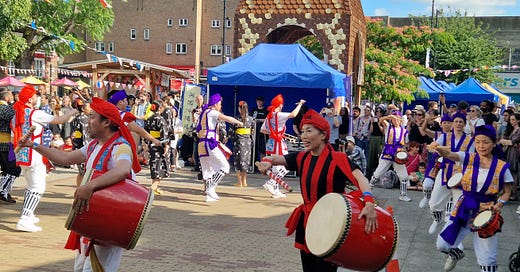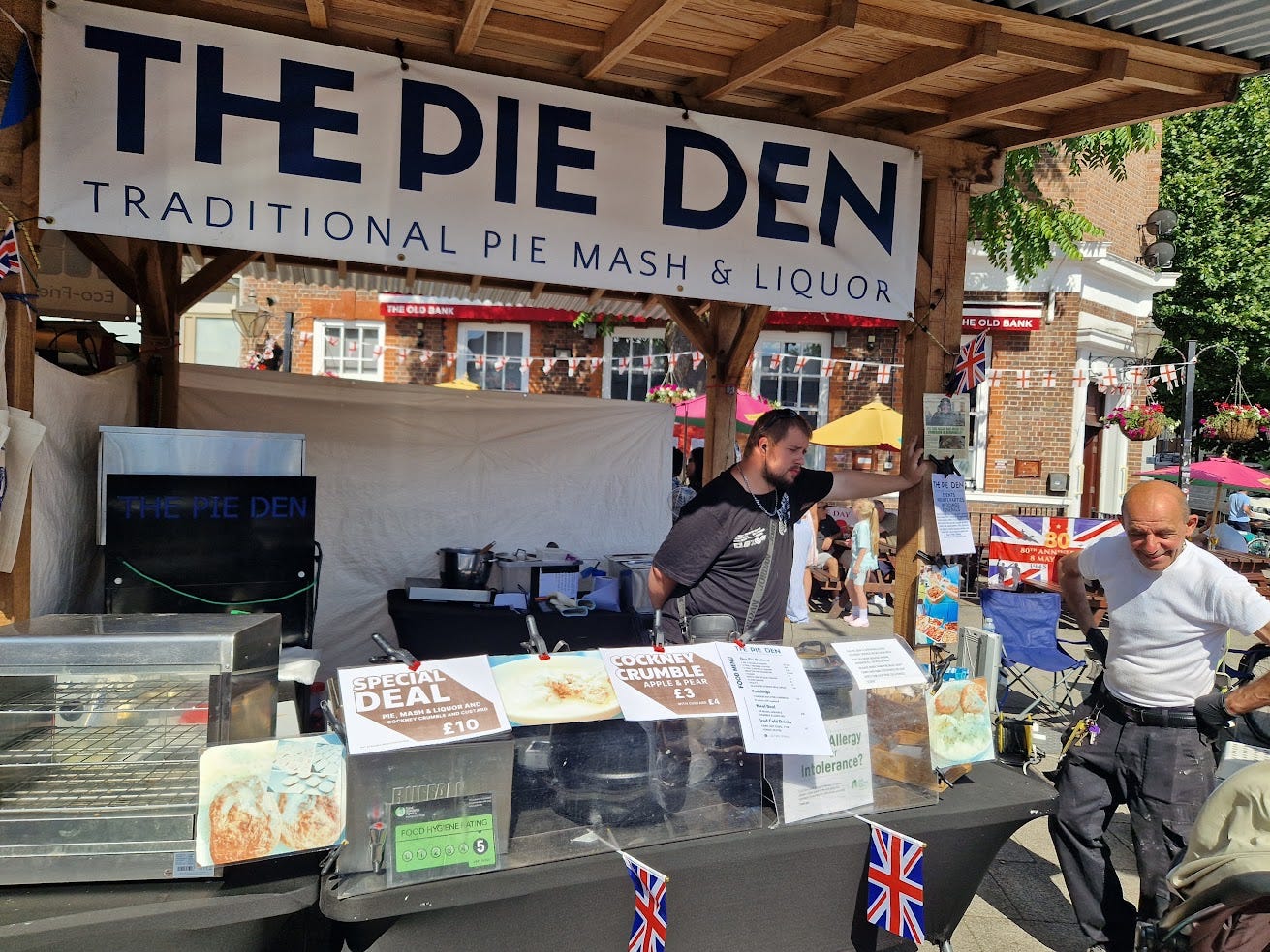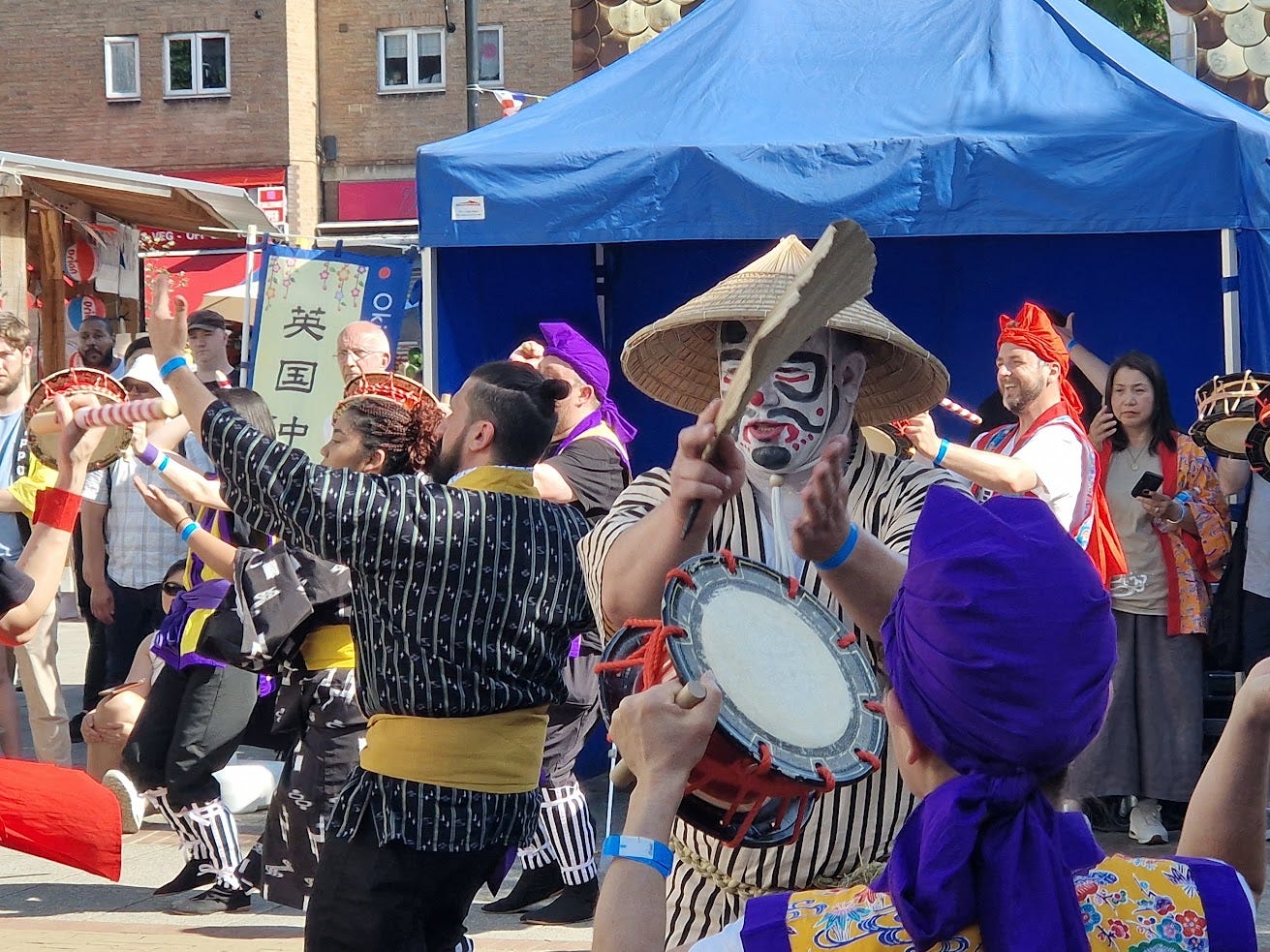Okinawa drummers and dancers performing at The Blue, Bermondsey’s public square.
Stranger things have surely happened but for older residents of Bermondsey, a south east London borough that borders the Thames, witnessing an Okinawa dance and drum troupe take over The Blue must have had them pondering what’s the world come to?
Bermondsey, for those unfamiliar with this borough, was long one of London’s more notorious postcodes. For generations this historic area was home to many men who worked on the docks - dockers became infamous for thieving from the vessels they unloaded alongside being very tribal (for a long time local council housing here was only given to those who had “family” in the area - a way of keeping non-whites out).
Bermondsey is also home to Millwall FC, a club noted less for its prowess on the pitch than for its thuggish supporters. While football hooliganism has fallen away in recent decades, when it flares up it often involves Millwall supporters - a visiting Everton supporter was slashed across the face during a pre-match 2019 brawl near The Den (Milwall’s stadium) and racist chanting still occurs at certain games.
The Milwall Lion, as seen in The Blue (and on ever supporter’s shirt/tattoo).
And The Blue, Bermondsey’s historic square, was for a long time the borough’s epicentre. This has changed in recent years as the development of the riverside - Tate Modern and all which has followed - has ensured Bermondsey’s become home to a new, more affluent community.
This means that the borough now hosts the Bermondsey Beer Mile - old factories and warehouses have been taken over by brewers, some of whom produce the best beer in Britain (Kernel is my favourite and has a great taproom - yes, in Bermondsey). The gentrification has also led to a rise in street crime: Rotherhithe, a historic Bermondsey neighbourhood by the river where old warehouses have been transformed into luxury apartments, suffers from amongst the highest rates of phone theft in the UK (and thus the world).
Which possibly explains the Okinawa Day taking over The Blue from 11am - 5pm today. The Blue may be “historic”, in the sense of a street market and pubs having existed here for centuries, but its current design is crap early 1970s concrete. This part of Bermondsey has not been gentrified (yet); many of the local shops are shuttered (including a huge Poundland) while the brightest traders are the Turkish grocers I wrote about here a few weeks ago. A Wimpy outlet still survives - Wimpy was the first British hamburger chain, one wiped out by the arrival of US chains in the 1970s. A Wimpy today is a sure sign of a backwater.
Union Jacks and a reference to “The Den”… old school street food.
Anyway, the market here is not comparable to East Street Market - which I visited earlier today to get a week’s produce (4 mangos for £4? Thank you!) - instead its moved more towards “street food”. An enterprising example being one trader offering pie & mash - the Cockney staple I wrote on late last year that is fast facing extinction. Yet at £7.50 a single pie/mash serving its priced more towards the new Bermondsey arrivistes than pensioners wanting cheap comfort food.
Just past the traders Okinawa Day has taken over The Blue. As there is no Japanese community historically living here its an odd location in which to celebrate the island from which much striking music is made; when I ask a woman behind a desk offering info’ on Okinawa why its held at this location she admits to having no idea.
Sanshin and player. Is the snake skin real? I don’t know.
Not that it matters - there are duos and trios playing the sanshin, an instrument often referred to as “the Japanese banjo”. Like the banjo, the sanshin creates a rather blunt but very resonant sound and I enjoy hearing it being played. On my one visit to Japan I found female sanshin players often performing in different locations across Tokyo, as if emblems of a “traditional” Japan amongst such a hyper, high tech society. Which is both bizarre - I mean, they would be playing in shopping centres (akin perhaps to New Orleans having trad jazz combos blowing in such). But, all in all, a good thing.
Looking at the programme, I noted the musicians appeared to be from the London Okinawa Sanshinkai - several of the players were Europeans and there was an Afro dancer - while a dance troupe hailed from Paris (from Paris to Bermondsey… they must have wondered where they were! I mean, Notting Hill this ain’t). I imagine this reflects how across our world cultures are shared and interracial relations are increasingly common (even though Japan is not a nation which encourages such).
Who was that masked man? No idea. Any info’ appreciated - he obviously loved his role, rushing about in the fierce sun.
The Okinawa Day’s highlight was the large drum and dance troupe who closed things with a truly spectacular performance. Here men and women and children all moved in circular patterns, many of them banging in unison hard rhythms while chanting. They were well drilled, no one losing their spot, surely encouraged by two men wearing masks and in traditional robes who ran amongst them, teasing and prompting, jesters of sorts. It was a great performance. The kind I might expect to find at WOMAD festival (not on this year) but not in The Blue.
If I was surprised at experiencing Okinawa Day here then I can only imagine what Bermondsey’s older residents must have made of this explosion of sound and dance. More please.
Mother and child beat out the pulse of an Okinawa dance rhythm.
PS later this evening I was watching the Glastonbury performance of rising British jazz drummer Yussef Dayes and he invited on stage Japanese musician Minami Kizuki - and she played sanshin! Maybe Okinawa music is having a moment?!?









